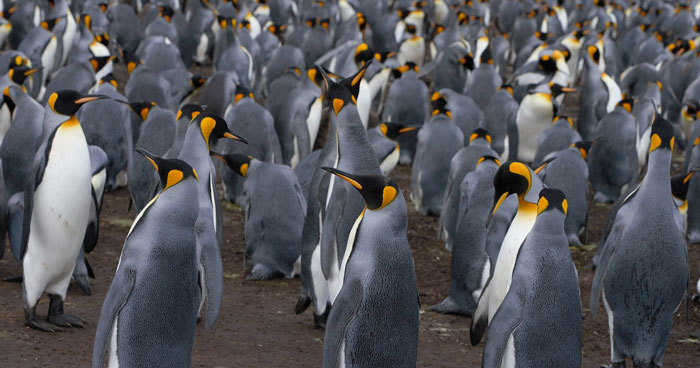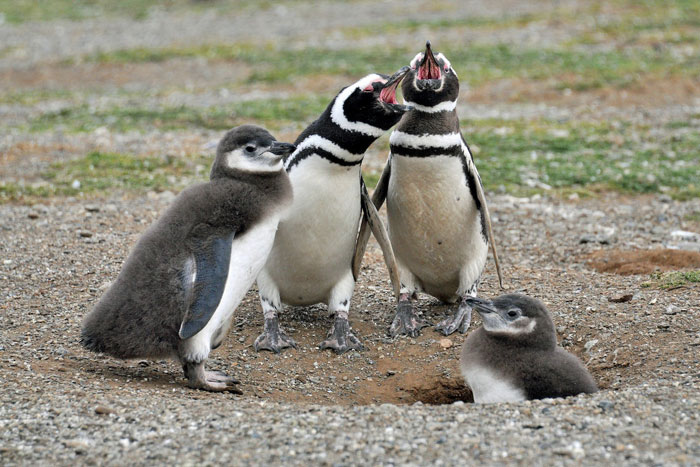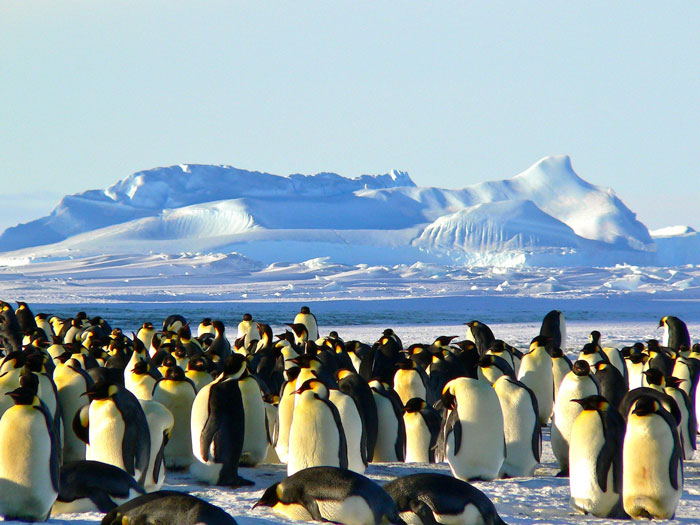If we had to choose one soul bird, we’d shoot for the ever-smart, ever-gorgeous raven. However, we also do understand that a majestical raven might not, in fact, be the most accurate representation. So, to stay real, our second-best choice would be a penguin. Yup, that waddly, squeaky, black-and-white master of the seas would be the most appropriate image of us. Funnily clumsy and always up for a snack, we bet some of you can relate to our choice, too! However, if you aren’t sure if a penguin is truly up for a soul bird role, keep on reading for some inherently cool penguin facts and learn more about their quirks and the stuff that makes them so relatable (and adorable!).
For instance, did you know that penguins are actually waterproof? That’s one of the traits that allow them to enjoy the waters of the freezing cold Antarctic sea! Or, were you aware that penguins, although clumsy on surfaces, are highly athletic swimmers and can dive to record depths? See, they aren’t just adorable; they are also very cool! But, to learn more, you’ll have to keep on reading the facts about penguins we’ve put in this article. After all, if we spill all of the coolest penguin trivia now, you’ll miss the chance to see all the adorable penguin photos that accompany the bird facts below. And if the fun facts about penguins don’t make your day, the painstakingly cute images sure will!
Right, so before we spill all the beans, let’s end this introduction and skip straight to the interesting facts about penguins. Once you are done reading these fun facts, be sure to rank them since now they are in no particular order. And lastly, share this article with your friends!
This post may include affiliate links.
 Male penguins propose with pebbles. Many male penguins present rocks to female penguins as a form of courtship.
Male penguins propose with pebbles. Many male penguins present rocks to female penguins as a form of courtship.
 Some penguin species are monogamous.
Some penguin species are monogamous.
Gentoos, rockhoppers, and chinstraps mate for life. Within minutes of arriving at the colony each season, Adelie females can locate their former mates.
Awww! And they share the parenting jobs, too. Penguins have the family thing down pat.
 Penguin chicks are incredibly fluffy.
Penguin chicks are incredibly fluffy.
A light down covers their first layer of feathers. They eventually develop a waterproof coating, but before that, they look rather adorable.
 Emperor penguins keep eggs warm by holding them on their feet.
Emperor penguins keep eggs warm by holding them on their feet.
They are kept warm by the male penguins inside a loose skin fold. They don't even leave to eat for months while waiting for the eggs to hatch!
 Very aptly named Little Blue Penguin is the smallest penguin species.
Very aptly named Little Blue Penguin is the smallest penguin species.
These tiny birds are also called little penguins or fairy penguins, and their miniature size of about 14 inches sure offers a stark comparison when put next to an emperor penguin's 4-foot-tall stature.
I saw these little guys at the New England Aquarium. Quite the loud bunch for smol penguins.
 Some extinct penguins were over 5 feet tall.
Some extinct penguins were over 5 feet tall.
An ancient race of penguins once stood taller than the average adult man today at 5-foot-10, according to recently unearthed remains. 60 million years ago, Kumimanu biceae was at the height of its might and likely weighed 220 pounds. Pachydyptes, an extinct genus, was likewise likely to grow to a height of around 4 feet.
 Penguins are toothless.
Penguins are toothless.
Their mouths have fleshy spines that assist them in swallowing fish. The protrusions face backward to assist in guiding the catch down their throats.
 Chubby penguins are the most sought-after mates.
Chubby penguins are the most sought-after mates.
Due to the extreme fasting required, the females frequently look for chubbier men who can go weeks without food as the females alternate fishing turns.
 "Brooding" refers to keeping an eye on the young penguin chick. If their chick was lost or perished, some mother penguins would attempt to abduct young penguin chicks.
"Brooding" refers to keeping an eye on the young penguin chick. If their chick was lost or perished, some mother penguins would attempt to abduct young penguin chicks.
Penguins are total crowd lovers.
When gathered on land, the greatest penguin colonies, known as rookeries or waddles, consist of tens of thousands of birds.
Penguins are pros at "tobogganing."
Instead of waddling across the ice, many penguins lay on their stomachs and propel themselves with their feet. It's generally a quicker method of transportation, plus it's just simply enjoyable.
 Many birds restrict their egg production.
Many birds restrict their egg production.
This occurs in a very peculiar way among crested penguins. With an interval of 6 days they lay two eggs. The first led egg is smaller than the second one—it is only half as big. Typically, only the second egg hatches. Even if both eggs hatch unexpectedly (as with the Fiordland penguin), only one baby will reach adulthood. The reason why is still a mystery.
 Penguins are adapted to drinking seawater.
Penguins are adapted to drinking seawater.
Although penguins drink meltwater from streams and pools when thirsty, their hunting habits and nutrition require sophisticated adaptation. Salt is eliminated from the bloodstream by a supraorbital gland placed above the eye. The extra sodium is subsequently expelled through the nose or by sneezing!
 And also dive down over 800 feet.
And also dive down over 800 feet.
In the deepest dive ever recorded by the Australian Antarctic Division, an emperor penguin reached an amazing 1,850 feet. Those huge depths require a great lung capacity; the longest-known dives have lasted 22 minutes!
Don't care how many feet or toes or whatever they go down, give me the meters
 Penguins molt once a year.
Penguins molt once a year.
During the two to three-week period, penguins lose all of their feathers, and until the crucial insulation grows back, they cannot swim or fish.
Penguins usually live for around 15 to 20 years.
The little blue penguins only live about 6yrs. Magellanic penguins live up to 30yrs.
 Penguins are capable of swimming faster than ten miles per hour.
Penguins are capable of swimming faster than ten miles per hour.
The fastest penguins, Gentoos, may move at speeds of up to 20 mph, although most species only go at 4 to 7 mph.
32.180 km/hr for Gentoos. Most other species go at 6.436 to 11.263 km/hr. Hope this helps
 Not all Penguins live in the Antarctic.
Not all Penguins live in the Antarctic.
Living close to the equator allows the Galápagos penguin to remain comfortable and warm. In actuality, they are the only species of penguins that live outside of the Southern Hemisphere.
 When it comes to size, Emperor penguins are the largest specimens of the species.
When it comes to size, Emperor penguins are the largest specimens of the species.
120cm and 40kg (though their weight fluctuates dramatically during the year).
 Scientists aren't sure how many penguin species there are, and although the count usually falls between 17 and 20, scientists disagree on whether some of them are species or just similar types of penguins.
Scientists aren't sure how many penguin species there are, and although the count usually falls between 17 and 20, scientists disagree on whether some of them are species or just similar types of penguins.
Penguin feather coloring provides camouflage.
When viewed from above, their black backs resemble the ocean's surface; when viewed from below, their white bellies resemble the brilliant surface. This protects them from predators like leopard seals and helps them catch prey like fish, squid, crabs, and krill.
 Penguins congregate to stay warm.
Penguins congregate to stay warm.
Emperor penguins have mastered the art of the group hug, with some birds in the middle of the embrace actually becoming too warm in temperatures below zero and needing to waddle out. Next, it's the turn of the guys on the periphery to feel the heat.
I saw a documentary on this. They set up cameras to tape the movement of the penguins. It was fascinating to watch. Every penguin gets his time in the warm middle, the cold outside, and everything in between. It looked like a set dance, with them weaving in and out, all of them knowing just where to go.
 Penguins are diving masters.
Penguins are diving masters.
Usually, before they dive into the water, penguins leap into the air and then plunge down. According to Smithsonian, the action causes air bubbles in their feathers to burst, reducing drag and doubling or tripling their underwater speed. Some smaller penguins can catapult themselves 6 to 9 feet into the air to leap back to land by rapidly swimming to the surface and bursting up over the ice shelf.
 Penguins create pebble nests.
Penguins create pebble nests.
Ornithologists refer to the "nests" of Gentoo penguins as "scrapes" because of how shoddy they appear. Yet, the parents cover the rock pile with soft moss and feathers.
A Canadian bird is the source of the penguin's name.
Pinguinus impennis was the scientific name of a now-extinct big auk. And, because it resembled the amusing black-and-white creatures travelers saw in the Southern Hemisphere, they borrowed Pinguinus to name them.
 Usually, a penguin snoozes with its bill hidden behind a flipper.
Usually, a penguin snoozes with its bill hidden behind a flipper.
I'm guessing that helps minimize heat loss. But apparently, they have a better sense of smell than regular birds, so there's that to consider.
 When measured in relation to the weight of the parent birds, penguin eggs are the smallest of all bird species.
When measured in relation to the weight of the parent birds, penguin eggs are the smallest of all bird species.
I'm not sure if that's a fair comparison when they (like loons & puffins) have solid bones unlike other birds, who have hollow bones.
 Only 19% of young penguin chicks will survive the first year of their life.
Only 19% of young penguin chicks will survive the first year of their life.
That’s sad. But then, there’s many species that don’t survive long after birth. I wouldn’t want to come back as a baby turtle (1 in a 1,000) but if they make it, they can live a very long time, between50 and 100 years. This is sea turtles.
Partners find one another by making distinctive calls.
When there are thousands of identical birds around, it can be difficult for them to reconnect on the nesting grounds, but the distinctive calls help.
The dense feathers of a penguin are not the only thing keeping this bird warm.
Its tail is equipped with a gland that produces waterproof oil. Each day, penguins spend several hours coating their feathers in this oil. Before swimming, they pay particular attention to the process.
Contrary to many well-known Christmas cartoons, polar bears and penguins never coexist in the wild. Penguins live south of the equator, and polar bears live in the Arctic, north of the equator!
 Penguins are waterproof.
Penguins are waterproof.
Penguins apply preen gland-produced oil to their bodies, insulating their feathers and enhancing their hydrodynamics.
The uropygial gland is located at the base of the tail, also called the oil gland or preen gland. Preen oil may also be antibacterial/ antimicrobial, which would come in handy when you go up to four months without a bath.
A gathering of penguins in the water is called a raft. Up to 80% of the lives of these devoted swimmers are spent at sea.
Penguins are adapted to sink.
According to BBC Wildlife Magazine, penguins have solid skeletons for easier diving, while other birds have hollow bones to aid in flight.
Some penguins dig burrows.
Little or fairy penguins dig tunnels in the sand dunes, usually leading to a "nest bowl" that is just big enough for one person to stand in. Up until they are around 8 or 9 weeks old, the males and females alternate turning the eggs and feeding the chicks.
For one bird to stand up in. Our local colony has wee nesting boxes for them to use, and a person would definitely not fit, let alone standing! XD
Feces can help researchers locate penguins.
The enormous colonies' profusion of dark excrement, or guano, makes it possible for scientists to observe the populations from space! An Adelie penguin "super-colony" with 1.5 million members was just discovered in the Danger Islands in 2018 because of the stinky giveaway.
penguins are magnificent creatures i cant imagine a world without them!
I know a raunchy joke about penguins, the seven dwarves, and the Pope.
penguins are magnificent creatures i cant imagine a world without them!
I know a raunchy joke about penguins, the seven dwarves, and the Pope.

 Dark Mode
Dark Mode 

 No fees, cancel anytime
No fees, cancel anytime 
















































